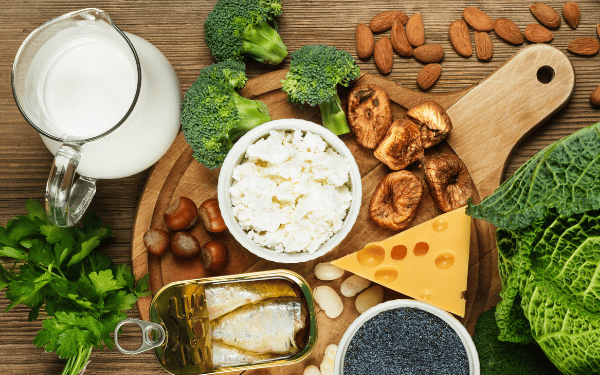

Calcium Rich Foods
Calcium: An Important Nutrient That Builds Stronger Bones

Bone is living tissue, constantly renewing itself. Although bone is strong and relatively flexible, everyday wear and tear causes tiny structural defects, much like those that occur in the foundations of a building over time. In our bodies, there are two groups of special cells that perform the work of a “maintenance crew.” Osteoclasts excavate any areas of damaged or weakened bone and then osteoblasts fill in the crevices with material that hardens to form new bone. This two-part process is called bone remodelling, and the cycle of remodelling is completed every three to four months in a healthy young adult.
As we age, the two groups of cells that form the maintenance crew become less efficient in working together – the osteoclasts remove old bone faster than the osteoblasts are able to rebuild it. In addition, calcium, like many nutrients, is absorbed less effectively as we age. In people who have relatively healthy bones, adequate calcium intake can help the remodelling process stay balanced. Studies of older adults show that adequate calcium intake can slow bone loss and lower the risk of fracture.
For those over 50, Canada’s Food Guide recommends 3 servings of milk and alternatives (2 servings for adults under age 50) – yogurt, cheese, calcium-fortified beverages, puddings, custards, etc. This essentially means that, if you are over 50, you need the equivalent of one good serving of dairy at each meal.
Take your pick: have a glass of milk (go ahead and have chocolate milk if you prefer), have soup that’s made with milk (like cream of mushroom soup), main courses made with cheese such as lasagna, or have yogurt with fruit for dessert. A 3 cm cube of hard cheese has as much calcium as a cup of milk. Skim milk products provide as much calcium as whole milk with the added advantage of less fat and cholesterol. Dairy products are an excellent source of calcium and are also a good source of protein.
If you are intolerant to dairy products or if you prefer to avoid dairy, there are other alternatives food sources that are high in calcium. These include:
- Calcium-fortified soy, almond and rice beverages (check the nutrition labels)
- Calcium-fortified orange juice (check the nutrition labels)
- Canned salmon or canned sardines. (When you eat the bones that have been softened by the canning process, these foods are excellent sources of calcium.)
| Calcium Content of Some Common Foods | Serving Size | Calcium* |
|---|---|---|
Buttermilk | 1 cup/250mL | 186 mg |
Fortified orange juice | 1 cup/250mL | 300 mg |
Fortified almond, rice or soy beverage | 1 cup/250mL | 300 mg** |
Milk – whole, 2%, 1%, skim, chocolate | 1 cup/250mL | 300 mg*** |
Milk, evaporated | 1/2 cup/125 mL | 367 mg |
Milk – powder, dry | 1/3 cup/75 mL | 270 mg |
Yogurt – plain, 1-2% M.F. | 3/4 cup/175 mL | 332 mg |
Almonds, dry roast | 1/2 cup/125 mL | 186 mg |
Beans – white, canned | 1 cup/250 mL | 191 mg |
Cheese – Blue, Brick, Cheddar, Edam, Gouda, Gruyere, Swiss | 1 ¼”/3 cm cube | 245 mg |
Cheese – Mozzarella | 1 ¼”/3 cm cube | 200 mg |
Drinkable yogurt | 4/5 cup/200 mL | 191 mg |
Frozen yogurt, vanilla | 1 cup/250 mL | 218 mg |
Fruit-flavoured yogurt | 3/4 cup/175 mL | 200 mg |
Ice cream cone, vanilla, soft serve | 1 | 232 mg |
Kefir (fermented milk drink) – plain | 3/4 cup/175 mL | 187 mg |
Molasses, blackstrap | 1 Tbsp/15 mL | 180 mg |
Salmon, with bones – canned | 1/2 can/105 g | 240 mg |
Sardines, with bones | 1/2 can/55 g | 200 mg |
Soybeans, cooked | 1 cup/250 mL | 170 mg |
Beans – baked, with pork, canned | 1 cup/250 mL | 129 mg |
Beans – navy, soaked, drained, cooked | 1 cup/250 mL | 126 mg |
Collard greens – cooked | 1/2 cup/125 mL | 133 mg |
Cottage cheese, 1 or 2% | 1 cup/250 mL | 150 mg |
Figs, dried | 10 | 150 mg |
Instant oatmeal, calcium added | 1 pouch/32 g | 150 mg |
Soy flour | 1/2 cup/125 mL | 127 mg |
Tofu, regular – with calcium sulfate | 3 oz/84 g | 130 mg |
Beans – baked, plain | 1 cup/250 mL | 86 mg |
Beans – great northern, soaked, drained, cooked | 1 cup/250 mL | 120 mg |
Beans – pinto, soaked, drained, cooked | 1 cup/250 mL | 79 mg |
Beet greens – cooked | 1/2 cup/125 mL | 82 mg |
Bok choy, Pak-choi – cooked | 1/2 cup/125 mL | 84 mg |
Bread, white | 2 slices | 106 mg |
Chickpeas (garbanzo beans) | 1 cup/250 mL | 77 mg |
Chili con carne, with beans – canned | 1 cup/250 mL | 84 mg |
Cottage cheese – 2%, 1% | 1/2 cup/125 mL | 75 mg |
Okra – frozen, cooked | 1/2 cup/125 mL | 89 mg |
Processed cheese slices, thin | 1 | 115 mg |
Turnip greens – frozen, cooked | 1/2 cup/125 mL | 104 mg |
Artichoke – cooked | 1 medium | 54 mg |
Beans, snap – fresh or frozen, cooked | 1/2 cup/125 mL | 33 mg |
Broccoli – cooked | 1/2 cup/125 mL | 33 mg |
Chinese broccoli (gai lan) – cooked | 1/2 cup/125 mL | 46 mg |
Dandelion greens – cooked | 1/2 cup/125 mL | 74 mg |
Edamame (East Asian dish, baby soybeans in the pod) | 1/2 cup/125 mL | 52 mg |
Fireweed leaves, raw | 1/2 cup/125 mL | 52 mg |
Grapefruit, pink or red | 1 | 27 mg |
Hummus | 1/2 cup/125 mL | 50 mg |
Kale – cooked | 1/2 cup/125 mL | 49 mg |
Kiwifruit | 1 | 26 mg |
Mustard greens – cooked | 1/2 cup/125 mL | 55 mg |
Orange | 1 medium | 50 mg |
Parmesan cheese, grated | 1 Tbsp/15 mL | 70 mg |
Rutabaga (yellow turnip) – cooked | 1/2 cup/125 mL | 43 mg |
Seaweed (agar) – dried | 1/2 cup/125 mL | 35 mg |
Snow peas – cooked | 1/2 cup/125 mL | 36 mg |
Squash (acorn, butternut) – cooked | 1/2 cup/125 mL | 44 mg |
*Approximate values.
**Added calcium may settle to the bottom of the container; shake well before drinking. ***Calcium-enriched milk – add 100 mg per serving.
The calcium in soy beverage is absorbed at the rate of 75% of milk. The calcium in some foods such as sesame seeds, rhubarb, Swiss chard and spinach is not well absorbed, because of very high oxalate content, which binds the calcium. Therefore these foods have not been included.